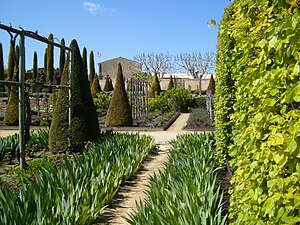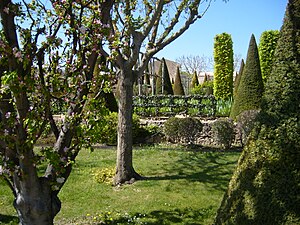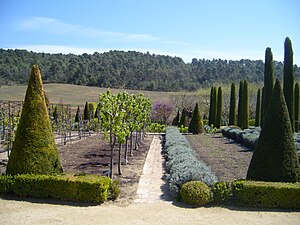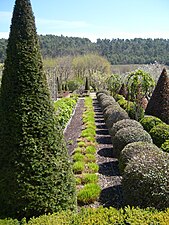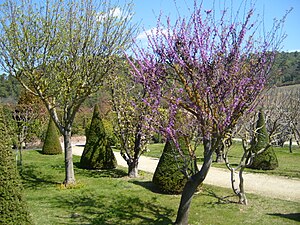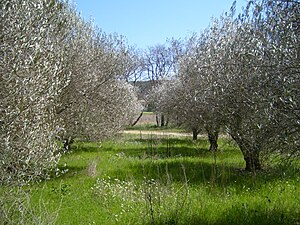60:. The estate was occupied by the Arnaud family, who kept it until the 17th century. In 1754, the estate was given the status of a fief. The house and estate fell into ruins during the 19th century. It was purchased in 1977 by Jean-Louis Chancel. Between 1979 and 1999, he planted 186 hectares of vines. He also commissioned the architect Jean-Jacques Pichoux to build a modern winery building, inspired by the architectural style of the
201:
147:
138:
17:
192:
183:
174:
165:
156:
67:
In 1978, Cécile
Chancel decided to build a garden in the style of a 17th-century kitchen garden. She had terraces dug on the hillside next to the vineyards, researched different garden styles, and, with the assistance of landscape gardener Tobie Loup de Vian, began building. The garden reached its
125:
Tables and seats are placed at scenic spots with views of the garden and the vineyards beyond. The best times to visit the garden are June and July for the flowers, or
September for the change of colors of the vineyards and trees.
56:
The
Chateau is built on the site of an ancient Roman villa, some of whose stones today decorate the garden. The building is decorated with the coat of arms of Jean de Joanis, the secretary of the King
314:
214:
44:, or Provençal manor, which stands on the site. They are private but open to the public, and are classified by the French Ministry of Culture among the
109:
The lower terrace features fruit trees, particularly old varieties of apples and pears. The garden also has a garden of herbs, a collection of
250:
235:
306:
87:, and aromatic plants and herbs. Different varieties of tomatoes are grown on bamboo frames, and there are pyramids of ivy and hops (
353:
45:
41:
279:
History cited on the web site of the
Committee of Parks and Gardens of the Ministry of Culture of France
29:
98:
57:
246:
231:
89:
61:
96:
The middle terrace features flowers, particularly roses. The paths are bordered with
347:
110:
200:
146:
137:
16:
68:
present form by 1990. It was classified as a
Remarkable Garden of France in 2005.
307:
Pictures and description on the site of the French
Committee of Parks and Gardens
270:
See site of the
Committee of Parks and Gardens of the French Ministry of Culture
329:
316:
191:
182:
173:
164:
155:
80:
37:
118:
33:
116:
An arbor or pergola covered with climbing roses and trumpet creeper (
84:
40:
Department of France. The gardens are inspired by the 17th century
79:
The upper terrace is a kitchen garden and flower garden, featuring
15:
103:
301:
113:, and boxwood hedges trimmed in ornamental forms.
122:) climbs the hill and joins the three terraces.
76:The gardens are laid out on three terraces:
8:
302:Site of the Jardins du Chateau Val Joanis
241:Phillipe Thébaut and Christian Maillard,
83:cut into spheres, squash, salad plants,
263:
133:
245:, Editions Payot & Rivages, 2008 (
215:Gardens of Provence-Alpes-Côte d'Azur
7:
32:winery, located west of the town of
20:Gardens of the Château de Val Joanis
288:Website of the Chateau Val Joanis.
14:
199:
190:
181:
172:
163:
154:
145:
136:
28:are gardens which belong to the
1:
26:Jardins du Château Val Joanis
46:Remarkable Gardens of France
106:trees trimmed into cones.
370:
243:Parcs et Jardins en France
228:ardins de France en fleurs
230:, Taschen, Paris, 2008. (
226:Marie-Françoise Valéry, J
21:
19:
354:Gardens in Vaucluse
326: /
58:Louis III of Naples
330:43.7112°N 5.4688°E
30:Château Val Joanis
22:
251:978-2-7436-1818-6
236:978-3-8365-0308-2
361:
341:
340:
338:
337:
336:
331:
327:
324:
323:
322:
319:
289:
286:
280:
277:
271:
268:
203:
194:
185:
176:
167:
158:
149:
140:
99:Iris × germanica
369:
368:
364:
363:
362:
360:
359:
358:
344:
343:
335:43.7112; 5.4688
334:
332:
328:
325:
320:
317:
315:
313:
312:
298:
293:
292:
287:
283:
278:
274:
269:
265:
260:
223:
211:
204:
195:
186:
177:
168:
159:
150:
141:
132:
90:Humulus lupulus
74:
62:Dominican Order
54:
12:
11:
5:
367:
365:
357:
356:
346:
345:
310:
309:
304:
297:
296:External links
294:
291:
290:
281:
272:
262:
261:
259:
256:
255:
254:
239:
222:
219:
218:
217:
210:
207:
206:
205:
198:
196:
189:
187:
180:
178:
171:
169:
162:
160:
153:
151:
144:
142:
135:
131:
128:
73:
70:
53:
50:
13:
10:
9:
6:
4:
3:
2:
366:
355:
352:
351:
349:
342:
339:
308:
305:
303:
300:
299:
295:
285:
282:
276:
273:
267:
264:
257:
252:
248:
244:
240:
237:
233:
229:
225:
224:
220:
216:
213:
212:
208:
202:
197:
193:
188:
184:
179:
175:
170:
166:
161:
157:
152:
148:
143:
139:
134:
129:
127:
123:
121:
120:
114:
112:
107:
105:
101:
100:
94:
92:
91:
86:
82:
77:
71:
69:
65:
63:
59:
51:
49:
47:
43:
39:
35:
31:
27:
18:
311:
284:
275:
266:
242:
227:
221:Bibliography
124:
117:
115:
108:
97:
95:
88:
78:
75:
66:
55:
25:
23:
333: /
72:Description
318:43°42′40″N
258:References
321:5°28′08″E
102:and with
348:Category
209:See also
81:lavender
38:Vaucluse
130:Gallery
119:Campsis
52:History
42:bastide
36:in the
34:Pertuis
249:
234:
111:asters
85:fennel
247:ISBN
232:ISBN
24:The
104:yew
93:).
350::
238:).
64:.
48:.
253:)
Text is available under the Creative Commons Attribution-ShareAlike License. Additional terms may apply.

